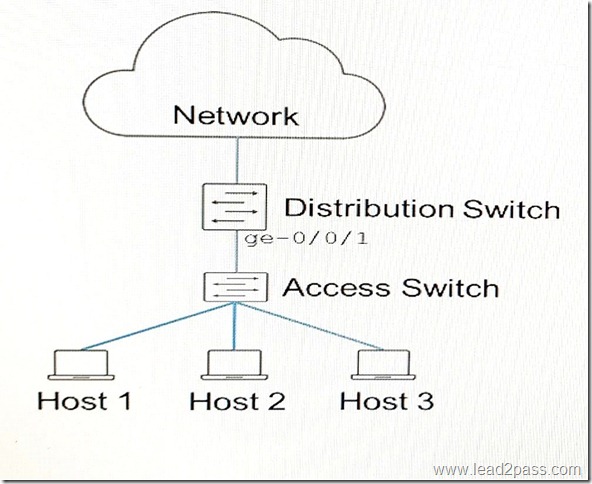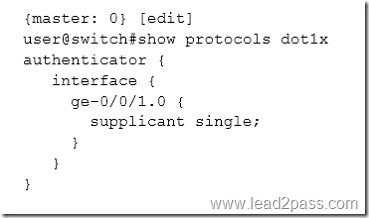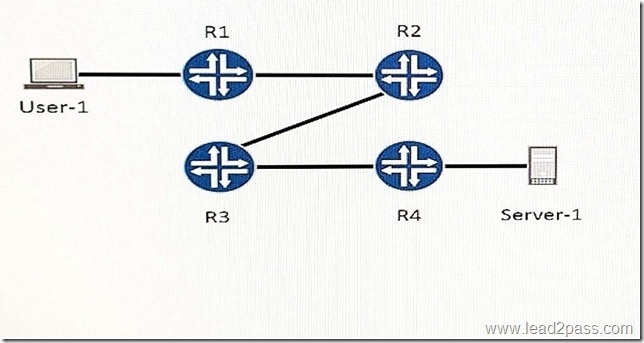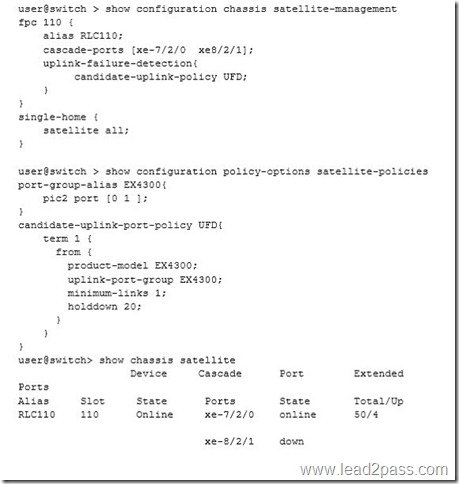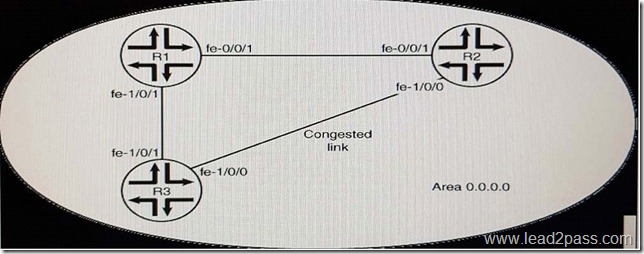100% Pass IT Exam By Training Lead2pass New VCE And PDF Dumps
100% Pass Lead2pass Practice Test Free Version
[April 2018] Free Sharing Of Updated JN0-347 VCE And PDF Dumps From Lead2pass 140q
Free Updated Lead2pass JN0-347 Exam Dumps Download:
https://www.lead2pass.com/jn0-347.html
QUESTION 1
What information is included in the DHCP snooping database? (Choose two.)
A. client MAC address
B. DHCP server address
C. DHCP options
D. VLAN
Answer: AD
Explanation:
When DHCP snooping is enabled, the lease information from the server is used to create the DHCP snooping table, also known as the binding table.
The table shows current IP-MAC bindings, as well as lease time, type of binding, names of associated VLANs, and associated interface.
http://www.juniper.net/techpubs/en_US/junos13.2/topics/concept/port-security-dhcp-snooping-els.html
QUESTION 2
Which three statements are correct about the voice VLAN feature? (Choose three.)
A. It allows the access port to accept tagged voice and untagged data packets.
B. It allows you to apply independent CoS actions to data and voice packets.
C. It can be used with LLDP-MED to dynamically assign the VLAN ID value to IP phones.
D. It allows trunk ports to accept tagged voice and untagged data packets.
E. It must use the same VLAN ID as data traffic on a defined interface.
Answer: ABC
Explanation:
A (not D): The Voice VLAN feature in EX-series switches enables access ports to accept both data (untagged) and voice (tagged) traffic and separate that traffic into different VLANs.
B: To assign differentiated priority to Voice traffic, it is recommended that class of service (CoS) is configured prior to enabling the voice VLAN feature. Typically, voice traffic is treated with a higher priority than common user traffic. Without differentiated treatment through CoS, all traffic, regardless of the type, is subject to the same delay during times of congestion.
C: In conjunction with Voice VLAN, you can utilize Link Layer Discovery Protocol Media Endpoint Discovery (LLDP-MED) to provide the voice VLAN ID and 802.1p values to the attached IP phones. This dynamic method associates each IP phone with the appropriate voice VLAN and assigns the necessary802.1p values, which are used by CoS, to differentiate service for voice traffic within a network.
https://kb.juniper.net/InfoCenter/index?page=content&id=KB11062&actp=search
QUESTION 3
Which two statements are correct about aggregate routes in the Junos OS? (Choose two.)
A. An active route can contribute only to a single aggregate route.
B. Only one aggregate route can be configured for each destination prefix.
C. An aggregate route has a default next hop of an IP address.
D. An aggregate route always shows as active in the routing table.
Answer: AB
Explanation:
A route can contribute only to a single aggregate route.
You can configure only one aggregate route for each destination prefix.
QUESTION 4
Which device is used to separate collision domains?
A. switch
B. router
C. hub
D. firewall
Answer: A
Explanation:
Modern wired networks use a network switch to reduce or eliminate collisions.
By connecting each device directly to a port on the switch, either each port on a switch becomes its own collision domain (in the case of half duplex links) or the possibility of collisions is eliminated entirely in the case of full duplex links.
https://en.wikipedia.org/wiki/Collision_domain
QUESTION 5
What are two types of IS-IS PDUs? (Choose two.)
A. open PDU
B. VRF PDU
C. hello PDU
D. link-state PDU
Answer: CD
Explanation:
IS-IS hello (IIH) PDUs broadcast to discover the identity of neighboring IS-IS systems and to determine whether the neighbors are Level 1 or Level 2 intermediate systems. Link-state PDUs contain information about the state of adjacencies to neighboring IS-IS systems.
http://www.juniper.net/documentation/en_US/junos15.1/topics/concept/is-is-routing-overview.html
QUESTION 6
What are three extended BGP communities? (Choose three.)
A. Origin: 172.16.100.100:100
B. domain-id: 192.168.1.1:555
C. extend:454:350
D. 172.16.90.100:888
E. target:65000:65000
Answer: ABE
Explanation:
The BGP extended communities attribute format has three fields:
type: administrator: assigned-number. type is the type of extended community and can be either the 16-bit numerical identifier of a specific BGP extended community or one of these types: origin– Identifies where the route originated.
domain-id– Identifies the OSPF domain from which the route originated.
target– Identifies the destination to which the route is going.
bandwidth– Sets up the bandwidth extended community. Specifying link bandwidth allows you to distribute traffic unequally among different BGP paths.
rt-import– Identifies the route to install in the routing table.
src -as– Identifies the AS from which the route originated.
You must specify an AS number, not an IP address.
https://www.juniper.net/techpubs/en_US/junos12.3/topics/usage-guidelines/policy-defining-bgp-communities-and-extended-communities-for-use-in-routing-policy-match-conditions.html
QUESTION 7
Which two statements are true about DIS elections in IS-IS? (Choose two.)
A. If a priority tie occurs, the router with the lower subnetwork point of attachment (SNPA) value becomes the DIS.
B. If a priority tie occurs, the router with the higher subnetwork point of attachment (SNPA) value becomes the DIS.
C. The router with the lower priority value becomes the DIS.
D. The router with the higher priority value becomes the DIS.
Answer: BD
Explanation:
In IS-IS, deterministic DIS election makes the possibility of predicting the router that will be elected as DIS from the same set of routers.
The router advertising the numerically highest priority wins, with numerically highest MAC address, also called a Subnetwork Point of Attachment (SNPA), breaking the tie.
https://kb.juniper.net/kb/documents/public/junos/StudyGuides/Ch4_from_JNCIP_studyguide.pdf
QUESTION 8
Host-1 was recently added in the network and is attached to ge-0/0/10 on Switch-A.
Host-1 is powered on and has its interface configured with default Layer 2 settings and an IP address on the 172.17.12.0/24 IP subnet.
Host-1’s MAC address is not shown in Switch-A’s bridging table.
What are three explanations for this state? (Choose three.)
A. The ge-0/0/10 interface is configured as an access port.
B. The ge-0/0/10 interface is not operationally or administratively up.
C. The ge-0/0/10 interface does not have an associated IRB.
D. The ge-0/0/10 interface has not received any traffic from Host-1.
E. The ge-0/0/10 interface is configured as a trunk port.
Answer: BCD
Explanation:
B: MAC learning messages received with errors include:
Interface down–The MAC address is learned on an interface that is down.
C: To configure the MAC address of an IRB interface Etc.
http://www.juniper.net/techpubs/en_US/junos15.1/topics/reference/command-summary/show-ethernet-switching-statistics-mac-learning-ex-series.html
https://www.juniper.net/documentation/en_US/junos16.1/topics/example/example-configuring-mac-address-of-an-irb-interface.html
QUESTION 9
Router-1 and Router-2 need to connect through the Internet using a tunneling technology.
Hosts that are connected to Router-1 and Router-2 will be sending traffic up to 1500 bytes.
The maximum segment size is supported across the path is 1520 bytes.
Which tunneling technology will allow this communication to take place?
A. GRE tunnel
B. IPsec VPN transport mode
C. IPsec VPN tunnel mode
D. IP-IP tunnel
Answer: D
Explanation:
Difference Between GRE and IP-IP Tunnel. Generic Routing Encapsulation (GRE) and IP-in-IP (IPIP) are two rather similar tunneling mechanisms which are often confused. In terms of less overhead, the GRE header is 24 bytes and an IP header is 20 bytes.
QUESTION 10
What are two interarea OSPF LSA types? (Choose two.)
A. Type-4 ASBR summary LSAs
B. Type 3 summary LSAs
C. Type 1 router LSAs
D. Type 2 network LSAs
Answer: AB
JN0-347 dumps full version (PDF&VCE): https://www.lead2pass.com/jn0-347.html
Large amount of free JN0-347 exam questions on Google Drive: https://drive.google.com/open?id=1zz9Rqxt1_dV6MXCzokBpQvuInCeVN-EX
admin April 26th, 2018
Posted In: JN0-347 Dumps, JN0-347 Exam Questions, JN0-347 New Questions, JN0-347 PDF, JN0-347 VCE, Juniper
Tags: JN0-347 braindumps, JN0-347 exam dumps, JN0-347 exam question, JN0-347 pdf dumps, JN0-347 practice test, JN0-347 study guide, JN0-347 vce dumps, Lead2pass JN0-347
[April 2018] Lead2pass JN0-647 New Questions For Passing The JN0-647 Certification Exam 80q
Lead2pass Juniper New Exam JN0-647 VCE Files Free Instant Download:
https://www.lead2pass.com/jn0-647.html
QUESTION 41
Which policy statement will be applied to neighbor 172.16.4.2?
A. policy-statement all and policy -statement agg
B. policy-statement agg
C. policy-statement all and policy -statement atat
D. policy-statement atat (more…)
admin April 16th, 2018
Posted In: JN0-647 Dumps, JN0-647 Exam Questions, JN0-647 New Questions, JN0-647 PDF, JN0-647 VCE, Juniper
Tags: JN0-647 braindumps, JN0-647 exam dumps, JN0-647 exam question, JN0-647 pdf dumps, JN0-647 practice test, JN0-647 study guide, JN0-647 vce dumps, Lead2pass JN0-647
[March 2018] 100% New Updated JN0-647 New Questions Lead2pass Helps Pass JN0-647 Exam Successfully 80q
100% Pass JN0-647 Exam By Training Lead2pass New VCE And PDF Dumps:
https://www.lead2pass.com/jn0-647.html
QUESTION 31
Click the Exhibit.
You have deployed the access control configuration to the distribution switch.
Referring to the exhibit, which statement is true?
A. All hosts connected to the access switch require authentication to access the network.
B. All hosts connected to the access switch will have access to the network after one host authenticates.
C. All hosts connected to the access switch will have access to the network without authentication.
D. Only the first host to authenticate will have access to the network, other hosts will be blocked.
Answer: B
QUESTION 32
Click the Exhibit.
Referring to the exhibit, traffic from User-1 is being forwarded to Server-1 with DSCP values that must be written. You must maintain the rewritten DSCP values throughout the network.
Which statement is correct in this scenario?
A. At a minimum, you must rewrite the DSCP values on R1.
B. At a minimum, you must rewrite the DSCP values on R1 and R4.
C. At a minimum, you must rewrite the DSCP values on R1, R2, and R3.
D. At a minimum, you must rewrite the DSCP values on R4.
Answer: D
QUESTION 33
Click the Exhibit.
You are adding a Junos Fusion satellite device but one cascade port is not coming on line.
Referring to the exhibit, what would cause this problem?
A. The satellite device is not an EX4300.
B. The cascade ports need to be on the same line card.
C. The FPC number must match the FPC connecting to the satellite device.
D. Interface xe-8/2/1 is in a link down state.
Answer: D
QUESTION 34
In Layer 2 environment where 802.1X is deployed with its default parameters on EX Series, which two statements are correct? (Choose two.)
A. RADIUS authentication requests are sent from authenticator to the authentication server.
B. DHCP traffic from supplicants is denied by default through the authenticator.
C. RADIUS authentication requests are sent from the supplicant to the authentication server.
D. DHCP traffic from supplicants is permitted by default through the authenticator.
Answer: AB
QUESTION 35
Click the Exhibit.
Your network is experiencing congestion across the link between R2 and R3. You must make changes to alleviate traffic congestion from R3 to R2.
Referring to the exhibit, which two commands would accomplish this task? (Choose two.)
A. [edit protocol ospf]
user@R1# set reference-bandwidth 10g
B. [edit protocol ospf]
user@R3# set reference-bandwidth 10g
C. [edit protocols ospf area 0.0.0.0 ]
user@R1# set interface fe-1/0/1 metric 5
D. [edit protocols ospf area 0.0.0.0 ]
user@R3# set interface fe-1/0/1 metric 5
Answer: BD
QUESTION 36
Which two statements are correct about using LLDP on junos devices? (Choose two)
A. LLDP operates on layer 2 and layer 3 interfaces
B. LLDP can interoperate with the cisco discovery protocol CDP
C. LLDP is enabled on all devices by default
D. LLDP operates on layer 2 interfaces
Answer: AC
QUESTION 37
You have certainly implemented the configuration shown in the exhibit. After committing these changes, the community devices connected to AS-1 are not able to communicate with the appropriate community devices connected to AS-2.
What must be done to allow these community devices to communicate?
A. You must configure an isolation VLAN ID Under the pvlan-200 on the AS2
B. switch You must configure the ge-0/0/10 interface on AS1 AS THE VPLAN on both switches
C. You must configure an isolation VLAN ID under the VLAN 200 ON both switches
D. You must configure the ge-0/012 interface on both switches as P VLAN trunks
Answer: D
QUESTION 38
Which two statements is true regarding the next hop attribute? (Choose two)
A. it is not changed when sent across EBGP sessions
B. it is changed to self for IBGP routes learned from EBGP
C. it is not changed for IGBP routes learned from EBGP
D. it is Changed by default when sent across EBGP sessions
Answer: CD
QUESTION 39
Your enterprise network is providing layer 2 connectivity between remote-sites using Q-in- Q tunneling. A customer wants to ensure their connection through your network is also participating in their spanning free topology. In this scenario, which solution must be used?
A. you must configure the Q in Q tunnel to use L2PT to tunnel STP packets
B. you must configure the same isolation ID on both sides of the tunnel
C. you must configure spanning tree on the interfaces connected to the customers sites
D. you must configure spanning tree to tunnel packets
Answer: A
QUESTION 40
You want to deploy MSTP with multiple regions. Each region should have a unique root bridge to accommodate a set of VLANs. Which three configuration elements must watch on switches participating in this deployment scenario? (Choose three)
A. MSTI toVLAN mapping
B. revision level
C. CST BPDU parameters
D. configuration name
E. bridge priority
Answer: ABD
JN0-647 dumps full version (PDF&VCE): https://www.lead2pass.com/jn0-647.html
Large amount of free JN0-647 exam questions on Google Drive: https://drive.google.com/open?id=1KdYnfjldTm71Qle4hxd8vwiskvK9pf_L
You may also need:
JN0-643 exam dumps: https://drive.google.com/open?id=0B3Syig5i8gpDQzh5Nk1hOG0tLUE
admin March 5th, 2018
Posted In: JN0-647 Dumps, Juniper
Tags: JN0-647 braindumps, JN0-647 exam dumps, JN0-647 exam question, JN0-647 pdf dumps, JN0-647 practice test, JN0-647 study guide, JN0-647 vce dumps, Lead2pass JN0-647
[January 2018] Free Share Lead2pass Juniper JN0-647 VCE Dumps With New Update Exam Questions 80q
Free Share Of Lead2pass JN0-647 VCE And PDF Dumps:
https://www.lead2pass.com/jn0-647.html
QUESTION 21
You are asked to merge a RIP network with your OSPF network. As a first step, you establish connectivity between the RIP network and the OSPF network. The RIP network connects to an NSSA area. Which two statements are true in this scenario? (Choose two.)
A. To share RIP routes with the OSPF network, an export policy will be required on the ABR.
B. To share RIP routes with the OSPF network, an export policy will be required on the ASBR.
C. By default, external OSPF routes have a higher route preference than RIP routes.
D. Be default, RIP routes have a higher route preference than external OSPF routes. (more…)
admin January 22nd, 2018
Posted In: Juniper
Tags: JN0-647 braindumps, JN0-647 exam dumps, JN0-647 exam question, JN0-647 pdf dumps, JN0-647 practice test, JN0-647 study guide, JN0-647 vce dumps, Lead2pass JN0-647
